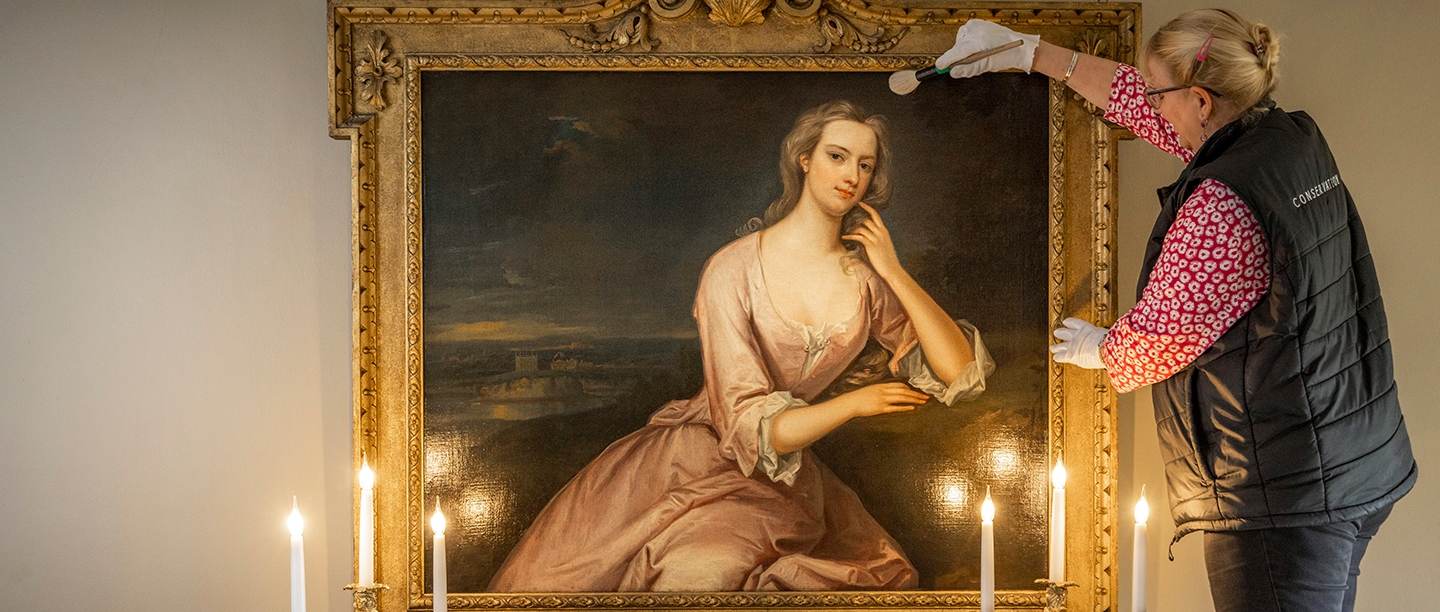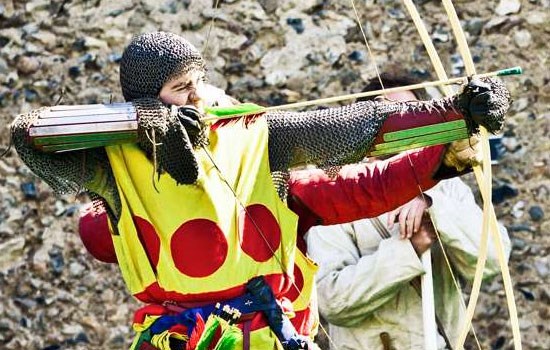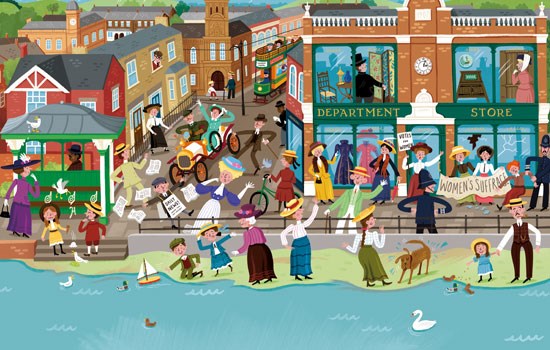
20 QUESTIONS QUIZ: COLLECTIONS
Test your knowledge about the objects in our collections with this quiz
-
1. Which of the following are not depicted in the 16th-century painting The Vegetable Seller, which can be seen at Audley End House and Gardens in Essex: A Hazelnuts B Strawberries C Garden peas
Answer: B Strawberries
The Vegetable Seller is a beautiful and somewhat mysterious painting in the collection at Audley End, a Jacobean mansion in the Essex countryside. A large work on canvas, it depicts an impressive array of fruit, vegetables and edible flowers, displayed in abundance in various bowls and baskets, almost spilling out of the painting. Surrounded by this striking presentation sits a lone female figure looking intently out at the viewer, perhaps a kitchen maid or a market stall seller. After many months of conservation, the painting was returned to Audley End in 2021.
-
2. Which Regency painter created the portrait of the Duke of Wellington that hangs in Apsley House in London?
Answer: Sir Thomas Lawrence
Wellington disliked sitting for portraits but he respected Lawrence and they became friends. Painted in 1817, the oil painting depicts Wellington in full military uniform, staring imperiously from the canvas. It was commissioned as a gift for a lady, Marianne Patterson, a wealthy American heiress whom Wellington greatly admired.
-
3. Answer
Answer: Corbridge Roman Town in Northumberland
During 350 years under Roman occupation, Corbridge Roman Town near Hadrian’s Wall grew from a military outpost into a bustling, cosmopolitan town with its own local identity. The exquisite sculpted lion discovered at the site in 1907 is the best preserved of five lion statues from Corbridge. The detailed carving depicts a male lion ferociously pouncing on its prey – the identity of which has confused sculptural experts. The horns and ears would suggest the sculptor was depicting a sheep or goat, but the size in comparison to the lion is that of a cow.
-
4. At which English Heritage site can you see 'Portrait of the Artist' by Rembrandt van Rijn, said to be the definitive self-portrait of this 17th-century master?
Answer: Kenwood
Considered to be one of the world's greatest masterpieces, this detailed painting is often cited as being Rembrandt’s definitive self-portraits out of the 80 or so he created during his career. Painted later in his life, when he was impoverished and alone, the painting shows the artist in his studio wearing working clothes – a fur-trimmed gown and white linen cap – and holding the tools of his trade. The two enigmatic circles in the background have puzzled people for centuries, and there is still no definitive answer as to their meaning or significance.
-
5. What did Mary Thornycroft and Abraham Kent sculpt for Queen Victoria in the 1840s that is on display at Osborne?
Answer: Marble sculptures of her children’s limbs
Wanting a memento of her children and to capture their fleeting infancy, Queen Victoria commissioned a series of marble sculptures of their hands, feet or limbs. The pure white marble sculptures were made using plaster casts and then presented on crimson velvet cushions kept under glass domes. She also commissioned jewellery made from her children’s milk teeth.

-
6. Who or what is Roaring Meg, and where would you find her?
Answer: Roaring Meg is the only surviving Civil War mortar in England and can be found at Goodrich Castle in Herefordshire
When Civil War broke out between King Charles I and Parliament in 1642, many castles that hadn’t seen action since the Middle Ages were pressed into service for one side or the other. Goodrich Castle was one of them, and soon became a Royalist stronghold. In June and July 1646 it was the scene of one of the most hard-fought sieges of the conflict. Parliament finally won with the aid of a huge mortar, Roaring Meg, reducing the castle to the picturesque ruin that survives today.
-
7. Madonna of the Pomegranate at Ranger’s House in London is a studio copy of Botticelli’s masterpiece. But where can you see the original?
Answer: The Uffizi, Florence
Bought by Julius Wernher in 1897, Madonna of the Pomegranate (Madonna della Melagrana) shows a pensive Mary holding Christ as a baby and surrounded by four angels. The pomegranate is symbolic of the future suffering of Christ. The version in the Wernher Collection was thought to be a later imitation of the c1487 masterpiece, but X-ray testing, infrared studies and pigment analysis have shown that it did come from Botticelli’s workshop in Florence. It is impossible to tell, however, how much input Botticelli himself had into this version, as multiple assistants were employed to help with his paintings.

-
8. This object was found in the outer curtain wall at Norham Castle on the Scottish border. But what is it?
- A - A pair of sugar tongs
- B - A dress lifter
- C - A torture device

-
8. Answer
Answer: B - a dress lifter
Dating from between 1840 and 1899, this copper alloy dress lifter was used to stop skirt hems from getting muddy and also to display decorative petticoats. Norham was a popular site for wealthy people to promenade around
-
9. Whose boots are on display at Walmer Castle and Gardens?
Answer: The Duke of Wellington
In the early 1800s Arthur Wellesley, then Viscount Wellington, asked his shoemaker to make boots in this style because they were easier to wear with trousers. After his victory over Napoleon Bonaparte at the Battle of Waterloo in 1815, Wellington's boots achieved the status of must-have fashionable footwear and duly became known as 'Wellingtons'. This particular pair is made of soft calfskin, polished black, with tan soles. Walmer Castle is also home to the Duke’s campaign bed (originally a piece of furniture that was used on the battlefield) and his death mask, created by portrait sculptor George Gammon Adams.

-
10. What transformed Hailes Abbey in Gloucestershire into an important pilgrimage site in the 13th century?
Answer: A holy relic believed to be a portion of the blood of Christ
While in Germany in 1268, Edmund, son of Earl Richard of Cornwall, the founder of Hailes, obtained what was believed to be a portion of the blood shed by Christ on the Cross – the Holy Blood, which was held within a crystal container. A 16th-century seal, used to grant admission to the abbey’s confraternity (or brotherhood), gives us the best impression of what the relic would have looked like. A priest is depicted holding an orb with a cross on top, which contains the Holy Blood of Hailes.

-
11. Brodsworth Hall and Gardens in South Yorkshire has a ‘Haydock’s Horse’. But what would you use it for?
Answer: Indoor exercise
Invented by Dr Haydock Wilbe in 1912, the ‘Haydock’s Horse’ was a model of a horse with springs to mimic the movement of a real horse and allow people to exercise in the comfort of their own home. It was bolted to the floor to stop the rider falling off. It’s believed that Charles or Augustus Thellusson, the owners of Brodsworth, would have bought this to help them keep fit as they got older
-
12. On display at Mulcheney Abbey in Somerset is a sculpture of a monk from the 14th century, who’s holding bread in one hand and a container of ale in the other. What was the name given to this container?
Answer: Costrel
It’s thought that this sculpture showed how the monks in the abbey were required to support members of the local community by giving them bread and ale. Mulcheney Abbey was mostly destroyed after the Dissolution of the monasteries in 1538, with only the abbot’s lodging surviving. This is where objects found during excavations in the 1870s are now displayed.
-
13. Wrest Park in Bedfordshire is home to an 18th-century outdoor sculpture of Venus and Adonis by John Cheere. Which English writer wrote a poem of the same name?
Answer: William Shakespeare
Shakespeare’s poem was published in 1593, and tells the story of goddess Venus’s unrequited love for Adonis and his tragic end during a hunting accident. It was dedicated to Henry Wriothesley, third Earl of Southampton.

-
14. Can you unscramble the name of this site, where a Viking raider stone was found? FRIENDLY PRISON AIR
Answer: Lindisfarne Priory
Dating from the 9th century, the Viking raider stone possibly commemorates the first Viking raid on the Anglo-Saxon monastery of Lindisfarne in AD 793. One face is carved with a sun, moon, two hands and two praying figures around a cross, which may refer to Doomsday. The other face has a procession of armed men bearing axes and swords.
-
15. What is unusual about the map surrounding the fireplace in the Map Room at Eltham Palace and Gardens in London?
Answer: It’s made of leather
Made specifically for the room in the 1930s, this leather map shows Eltham Palace in the centre, with local landmarks such as the Crystal Palace and the Royal Naval College also depicted. It was assembled by sewing together many small square pieces of leather. It’s part of the larger Map Room, whose walls were adorned with maps from around the globe, along with murals depicting everything from St Paul's Cathedral in London to Santa in his sleigh. The maps and murals had been covered over with wallpaper after the Courtaulds left Eltham in 1945, but they underwent extensive conservation work in 2015 and are now on show to the public.
-
16. Answer
Answer: Henrietta Howard, 9th Countess of Suffolk
Henrietta Howard was an influential courtier and patron of the 18th century. Her London home Marble Hill was inspired by a Palladian villa and furnished in the fashions of the day, including blue and white porcelain and lacquer furniture. The contents of the house were dispersed before the property came into public ownership in 1902, although some have made their way back. The paintings, furniture and porcelain on display in the house today still evoke the 18th-century love of east Asia, and suit Henrietta Howard’s taste and status.
-
17. In the great hall at Battle Abbey School there is an oil painting depicting the Battle of Hastings. What is the connection between the painting and the former owner of Battle Abbey, Sir Godfrey Webster?
Answer: Sir Godfrey was the model for William the Conqueror
Sir Godfrey commissioned this large-scale painting from Francis William Wilkin (1791–1842), who specialised in portrait miniatures and engravings. It was rediscovered in 1939, badly damaged, in a local museum. English Heritage conserved and rehung it in 2002, and it’s hung in the great hall, the location for which it was originally intended, which is now part of Battle Abbey School.

-
18. In Chiswick House and Gardens in London you’ll find a pair of porphyry vases from the 16th century. But what is porphyry?
Answer: A hard purple volcanic rock
Porphyry was a highly prized material in 16th-century Italy, and Roman columns and sculptures were reused to create new pieces such as these vases. They were bought by the owner and architect of Chiswick House, Lord Burlington, when he was on a Grand Tour of Europe in 1715. Lord Burlington was known as ‘the Apollo of the arts’, as he was one of the greatest 18th-century patrons and art collectors. He hung so many paintings inside the house that they almost obscured the velvet wall hangings.
-
19. Which Victorian scientist had a wooden slide installed on the staircase in his house?
Answer: Charles Darwin
Darwin commissioned a local carpenter to install the slide soon after moving to Down House in Kent. While it was principally for the amusement of his 10 children, there are records of Darwin’s wife Emma and the children’s governess also having a go. The slide is still in place today.
-
20. An arch at Housesteads Roman Fort was probably part of a niche containing a statue or altar to Mars Thincsus. From which country does this war god originate?
Answer: Germany
Dating from the 3rd century AD, the stone arch came from a temple built by the Frisians. It features a figure of Mars in the centre, holding a spear in his right hand and a shield in his left. The figures in the side panels are naked and cross-legged; both hold a raised torch in one hand and a large wreath in the other. It’s possible that they are wingless cupids. In this context they could symbolise victory in battle under the protection of Mars Thincsus. The arch is now on display at Chesters Roman Fort and Museum.

You may also be interested in






